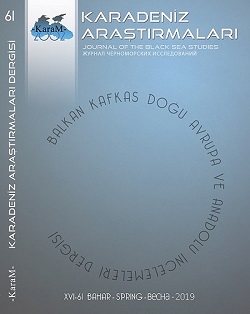Kuman, Ermeni Harfli Kıpçak ve Karay Türkçelerinin Ortak Söz Varlığı Üzerine
On Common Vocabulary of Kuman, Kipchak Turkish in Armenian Script and Karaim Turkic
Author(s): Abdulkadir ÖztürkSubject(s): Language studies, Geography, Regional studies, Modern Age, Lexis, Sociolinguistics, 13th to 14th Centuries, 15th Century, Turkic languages
Published by: Karadeniz Araştırmaları Merkezi
Keywords: Codex Cumanicus; Kuman Turkic; Kipchak Turkish in Armenian Script; Karaim Turkic; Vocabulary;
Summary/Abstract: Kuman Language spread across from Central Asia to Hungary has an important place in the Turkic Language. In the 14th century, the Genoese or Venetian traders and German missionaries, priests, written by the thought that Codex Cumanicus is an important source of work between living in the north of the Black Sea Kuman-Kipchak with communities of different nationalities used as a trade language Kuman Turkic. In the historical Kipchak Turkish this dialect created with Armenian scripts in the 17th and 18th centuries the Polish State of the past, on today’s lands of eastern europe and named to in Kipchak Turkish in Armenian Script or Armeno-Kipchak in the literatüre has some common features with Cuman Turkic and Karaim Turkic. Karaim Turkic, which dates back to the historical periods of Kipchak Turkic and is its contemporary representative has continued its existence with the written texts between of the sixteenth and twentieth centuries. Karaim Turkic which pausing activities of publishing with in the twenty-first century is a Kipchak dialect that is under the threat of extinction today. In this study, will be put forward examining similarities in terms of language features that are common words in Kuman, Kipchak Turkish in Armenian Script and Karaim Turkic.
Journal: Karadeniz Araştırmaları
- Issue Year: 2019
- Issue No: 61
- Page Range: 78-92
- Page Count: 15
- Language: Turkish

